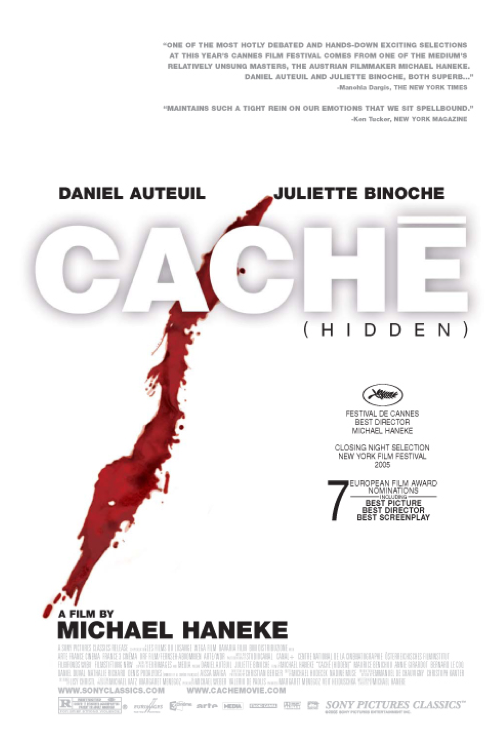What does hide the poster of Hidden?

The poster of Michael Haneke’s 2005 psychological thriller film «Hidden» presents a white space with the bright red mark — the main detail, wild shape, and color of which clearly resemble blood. It informs us about the upcoming danger and death. A viewer is inclined to understand the symbol of death as a threat to the main hero (like his own reflection and an ally), but the white background neutralizes explicit negative context, making all image anonymous and indifferent: the white color doesn’t let us to find (even on an emotional level) the source of danger and the victim, that reinforces the feeling of an alarm.
The movie starts with the long frame of the street. We don’t know what we are looking at, nothing happens. Then we find out that this frame is an anonymous videotape with a recording of the street where live a prosperous Parisian intellectual couple — Anne and Georges Laurent (starring Juliette Binoche and Daniel Auteuil). In addition to the notice about surveillance, they get postcards with strange scary pictures like in childish-style (that also indicates the presence of the Other — there are a lot of conflicts with opposite heroes, for example, a clash of Georges with a black stranger on the street). The dramaturgy of «Hidden» sometimes is similar to the detective genre, but it always misleads us.
So with the movement of the plot, we see shots that repeat the content of the pictures of unknown sender, but they are shown like a dreams of the main hero, so we can’t be sure that accidents, like the chopping off the head of the rooster or a boy spitting blood, really happened because these occasions were told by young Georges (who tends to lie even in the adulthood) to his parents in order to get rid of the boy Majid — a son of Algerian farmhands who disappeared in the Paris massacre of 1961. Following Georges’s logic and the content of videotapes, we become to suspect the Majid, who renounces the authorship of the massages and kills himself, but the videotapes continue to arrive.

Another one bright stylistic feature is an uncertain change from videotape or from the dreams (or memory) to the reality of film what makes us doubt. There is no score in the film, which makes it more realistic.
One of the main noted themes is the Paris massacre of 1961. The Parisian Police, that was chaired by Maurice Papon (who led the police in Paris during the Nazi occupation, applying violent methods after that, being supported by the government), attacked the demonstration of 30000 France’s Arabs, who opposed the Algerian War. Only in 1998 (when Papon went to trial for his Vichy record), the French government confirmed 40 deaths, although there were from 100 to 300 victims. In 2001 the memorial plate was installed in Paris.
Such concealment of truth, hiding the information about this event (Haneke sad, that he had never heard about it before 2001) is reflected in the movie by hiding answers in all its sides: the husband lies to his wife, son lies to his parents, child disappears, dreams are not exactly the part of the memory and what is the most important — we will not find out the sender, the anonymous power, that knows the past and controls the present.

Haneke began writing the screenplay by September 2001 (a period of Islamic terrorists’ attacks in the USA) — the time when the mass Surveillance became an ordinary phenomenon. Haneke analyses it making surveillance able to control such private parts of lives like memory and feeling of guilt.
The poster as a film isn’t a riddle with the answer (on the image we even don’t see the actors’ faces) — was that force the Georges or a director or God. It is a multilayer construction of the diagnosing of modern society. We see the unlimited power of this unseen force. The poster shows that there will stay only blood (exactly like the blood on the wall in Majid’s room) that will be acting as a сut on the Blindspot of the collective memory.
